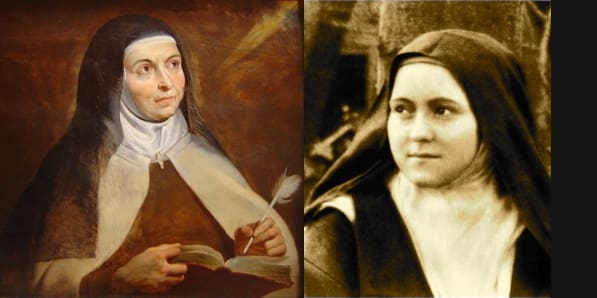2 Doctors, 2 Ways, 1 Goal: Sts Teresa and Therese (Part II of III)
Editor’s note: In part I, we talked about the goal of every pilgrimage, our Carmelite Doctors of the Church, and Saint Thérèse of Lisieux, specifically. Today we will look at Saint Teresa of Avila, in particular, and the way these Daughters of the Church differ from each other.
Saint Teresa of Avila (Saint Teresa of Jesus)
St. Teresa of Avila cautioned her Sisters not to lose courage regarding the path that would lead them to the summit of Carmel by the following advice:
Do not be dismayed, daughters, at the number of things which you have to consider before setting out on this divine journey, which is the royal road to heaven. By taking this road we gain such precious treasures that it is no wonder if the cost seems to us a high one. The time will come when we shall realize that all we have paid has been nothing at all by comparison with the greatness of our prizes. (Way of Perfection, Chapter 21)
Both saints succeeded in reaching their goal but the paths they followed were quite different. And although both are invaluable guides to us, the path that God marks out for us may be similar or look very different. Life may offer many peaks for us to climb and each one becomes a new challenge, a hard-earned lesson. It is the transformation that takes place as we struggle to reach the peak that enables us to climb the next one until we finally reach the ultimate peak of life’s journey.
When Thérèse, the over-sensitive child who cried because she cried, passed from childhood to the beginnings of adulthood she knew that God had granted her a miraculous conversion on that Christmas when for the last time she received gifts in her shoes, a custom reserved for children. Now she felt strengthened and was ready for the spiritual climb!
How did the Two Ways or the Two Paths of our Two Saints Differ?
In our spiritual journey we all descend into the valleys and climb back up the slopes of the mountains. Sometimes we slip or fall back, get hurt, or need to re-evaluate the path we are on. St. Teresa saw these as ebbs and flows in the spiritual life which provide us with the skills that we need to progress on our journey. We gain new understanding about ourselves and the lessons that we learn aid us in overcoming new difficulties that lie ahead.
Teresa of Avila did not have a theological background; her education was limited. But God led her on the path of mystical prayer. What was unique in her was her ability to understand and reflect upon the gift she had received and to articulate that gift especially in her writings. The benefit that the Church received from this led to her being acclaimed as a Doctor of the Church. She anticipated in her Interior Castle what the Second Vatican Council would proclaim in Lumen Gentium: that these different stages of prayer, both ascetical and mystical, are a natural progression in the Call to Holiness for all of us.
On the other hand, St. Thérèse gave us a glimpse of the path that she was called to follow when she wrote:
You know, Mother, that I have always wanted to become a saint. Unfortunately when I have compared myself with the saints, I have always found that there is the same difference between the saints and me as there is between a mountain whose summit is lost in the clouds and a humble grain of sand trodden underfoot by passersby. Instead of being discouraged, I told myself: God would not make me wish for something impossible and so, in spite of my littleness, I can aim at being a saint. It is impossible for me to grow bigger, so I put up with myself as I am, with all my countless faults. But I will look for some means of going to heaven by a little way which is very short and very straight, a little way that is quite new[…] It is your arms, Jesus, which are the lift to carry me to heaven, And so there is no need for me to grow up. In fact, just the opposite: I must stay little and become less and less (Story of a Soul, Chapter IX).
Thérèse found the little way of holiness by scattering the flowers of good deeds and sacrifices. For her everything was a grace and she used every opportunity that presented itself in her ordinary life to give back to Jesus the love He showered on her. She presented herself to Him as a trusting child. So well did she do this that the Sisters in her own Carmel wondered what the Prioress would say about her on her death since they felt she had done nothing.
Climb every mountain,
Search high and low,
Follow every highway,
Every path you know.
Thérèse did climb every mountain in her brief life; she considered the highways and paths that other great saints had taken and realized that in her weakness she needed a different route. So she searched high and low in Scripture to find a short cut to holiness and at last wrote:
We live in an age of inventions. We need no longer climb laboriously up flights of stairs; in well-to-do houses there are lifts. And I was determined to find a lift to carry me to Jesus, for I was far too small to climb the steep stairs of perfection. So I sought in Holy Scripture some idea of what this life I wanted would be, and I read these words: ‘Whosoever is a little one, come to me.’ It is your arms, Jesus, that are the lift to carry me to heaven. And so there is no need for me to grow up: I must stay little and become less and less (Story of a Soul, Chapter IX)
Editor’s Note: In the last installment of this series, we’ll put what we’ve considered in these posts into perspective.
This post originally appeared on the website of the Carmelite Sisters of the Most Sacred Heart of Jesus of Los Angeles. Used with permission.
Art: Mirror of Teresa of Avila, Peter Paul Rubens, 1615 and sepia of Therese von Lisieux, unknown photographer, between 1888 and 1896; both PD-US copyright expired, Wikimedia Commons, original composite Liz Estler.





